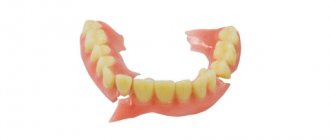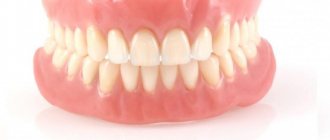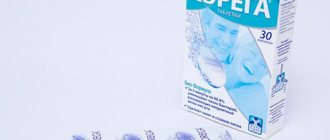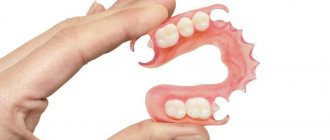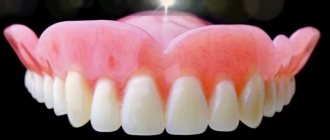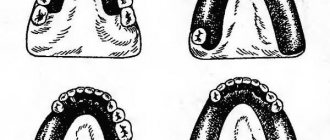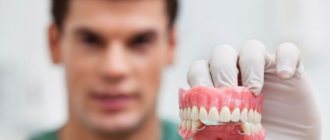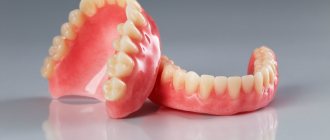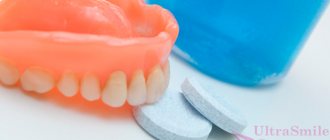Material
For the manufacture of orthodontic structures, dental nylon is used, endowed with some useful properties.
For example, it is flexible and very similar in appearance to real fabrics. Sometimes flexible nylon dentures are called “invisible”, and this is true, because they literally merge with the mucous membrane and look very realistic. And from the outside it is not at all noticeable that a person’s teeth are not “his own”, but artificial. Dental nylon has such a property as softness. This material is pleasant to the touch, despite the fact that it is a type of plastic. Ordinary plastic, from which orthodontic structures were previously made (and are still made) has a number of serious disadvantages. For example, products made from it rub the gums and are highly hard, which means that when wearing a plastic prosthesis, a person experiences not the most pleasant sensations and even discomfort. It is noteworthy that flexible nylon dentures are fixed to the supporting teeth using soft clasps.
Mini-implantation and overdentures
Mini-implants are designed to improve the fixation of removable nylon dentures on the patient's jaw. Such dentures are sometimes called overlay dentures. This method refers to conditionally removable prosthetic methods.
Mini-implants serve as support for overdentures, and fixation (clicking) is carried out using silicone matrices. The simplest and most convenient is the spherical (push-button) fastening, which requires the implantation of at least 2-4 implants. The greater the number of supports, the more reliable the fixation will be, the less likelihood of bone tissue atrophy, but the higher the overall cost of prosthetics.
The main advantages of mini implantation are reliable fixation of the prosthesis, the ability to install implants without incisions, the ability to install a covering prosthesis immediately after, no need for bone grafting, and the cost is lower when compared with classical implantation.
The main disadvantages are that the plastic base cannot cope with loads like real teeth, the load is still not distributed evenly enough, and fixed prosthetics are not feasible.
Interesting facts about dental nylon
Nylon is a thermoplastic that scientists have been studying for almost 70 years. As you know, nylon is a type of plastic that becomes highly elastic when exposed to a certain temperature. This property makes it possible to artificially recreate human organs and tissues, and research in this area is still ongoing. Over time, nylon was recognized as a safe material for the human body. And therefore it began to be actively used not only in dentistry, but also in medicine.
Americans were the first to “try on” nylon dentures. There is even a version that such orthodontic structures were created specifically for people in “extreme” professions (rescuers, police, military, firefighters, stuntmen). The professional activity of these people is associated with constant risk, and therefore dentures for them must be made of elastic materials, and nylon is most suitable for these purposes. Orthodontic products made from it are durable and not so easy to break. In Russia, prosthetics with nylon prostheses is just gaining momentum, and this know-how appeared back in 2001.
It is worth noting that both materials and technologies are constantly being improved, and now there is an incredible number of varieties of nylon used in different areas of human activity. For example, dental technicians and dentists around the world are well aware of nylon called AcryFree, which successfully combines the positive characteristics of nylon and acrylic. It is this material that is more suitable for the manufacture of complete removable dentures, since this symbiosis is ideal in all respects.
Name and definition
In 1956, the American company Valplast developed a nylon-type super-polyamide as a material for dentures. Dentures in which all structural elements except artificial teeth are made from this thermoplastic polymer without the use of metal are predominantly known under the company name Valplast, but are also called flexible dentures or nylon dentures, and are widely used throughout the world (Figure 1) [5], [6]. In Japan, these prostheses were individually imported and used on an experimental basis before they were approved by the Ministry of Health, Labor and Welfare and became commonly known as "clasp-free prostheses" or "metal-free prostheses." Since their pharmaceutical legalization in April 2008, numerous thermoplastic plastics have been developed and erroneously referred to by the names of their manufacturer, supplier or laboratory; however, in general, the name “claspless dentures” has taken root among general dentists.
Rice. 1. Removable denture with non-metallic clasps without metal elements.
According to GPT-8 [3], a clasp is defined as “a component of a retaining assembly enclosing a portion of the surface of a tooth, either inserted into an undercut for retention or positioned above the contour of the tooth as a reciprocal element; typically used to stabilize and retain removable dentures.” According to this definition, the clasp is not characterized as being made of metal. Plastic retention elements known as "hands", "fingers" and "wings" can thus be considered true clasps under this definition as they use undercuts to retain and stabilize partial dentures and are also known as "plastic clasps". or “aesthetic clasps” [7], [8].
Therefore, this interpretation means that the term “claspless dentures” refers only to those dentures that do not contain clasps in any form, such as locking dentures, milled dentures or telescopic dentures. Thus, in this policy document the name “prostheses with non-metallic clasps” (PNMC) is used to refer not only to prostheses that do not have any metal elements, but also to prostheses containing metal overlays or a clasp frame (Fig. 2, Fig. 3), and is defined as “the general name for removable partial dentures using base resin as retention parts of the denture.” Consequently, this definition includes not only those prostheses in which the retaining parts and the base are made as a single whole, but also those prostheses in which the plastic of the retention parts differs from the base. (Fig. 4). In this policy document, the plastic retaining part of the prosthesis is referred to as a “plastic clasp.”
Rice. 2. Prosthesis with non-metallic clasps, but with metal overlays.
Rice. 3. Clasp denture with non-metallic clasps (Reigning N®). a) Basal surface of the prosthesis; b) metal plate and plastic clasp.
Rice. 4. Prosthesis with non-metallic clasps using different plastics for retention elements and the base of the prosthesis. a) Plastic clasp on the working model; b) prosthesis ready for delivery.
Advantages
- Orthodontic structures made of nylon break very rarely, which cannot be said about their acrylic counterparts, in which fracture of the bases is the main problem, occurring in 80% of cases.
- Hypoallergenic. Such products cannot cause an allergic reaction. And this is easy to prove with a simple example: after polymerization of acrylic, its composition contains up to 10% of the liquid (monomer) used to carry out this process. This substance is a strong allergen, and it can be released for five years from the date of installation of the structure. Nylon dentures do not contain monomer.
- Installation of the product does not imply grinding of the supporting teeth, that is, they are not required to be prepared.
- The absence of metal elements is a significant advantage, because they are too noticeable when talking and smiling. The nylon orthodontic structure is completely indistinguishable from real teeth.
- If the product is made correctly, it will not rub the gums and will not cause discomfort.
- Nylon has a uniform structure, which is explained by the peculiarities of its production, which means that a product made from it will fit as tightly as possible to the gum.
- Inability to color and absorb moisture are very important characteristics of the material.
- Such structures do not tend to loosen the supporting teeth, which is very important if they are affected by periodontitis. It is noteworthy that it is possible to get dentures in this way even if you have some dental diseases, and this method even allows you to strengthen your dentition, which greatly contributes to a speedy recovery.
- Reliable fixation without glue, gel and crowns, which is the merit of clasps.
- A nylon prosthesis, the price of which is affordable for almost everyone, is designed for 5-7 years of intensive use. But only if you follow all the care recommendations that a specialist from the A-Medic clinic will certainly give.
Opinions are divided!
Some patients are completely satisfied with orthodontic structures made of nylon, while others, on the contrary, tend to abandon them and give preference to acrylic analogues. Why is that? Because the Earth is full of rumors, and reviews read on the Internet and the opinions of friends who have had negative experiences wearing nylon prostheses can play a cruel joke on the patient. Where did this stereotype come from? The fact is that the first nylon structures were very soft and elastic, and at first foreign dentists used them only for temporary prosthetics, since the cost of nylon dentures was very affordable.
Their appearance in Russia greatly delighted less than honest dentists, who began recommending to their patients the installation of just such dentures, rather than acrylic ones. This “aggressive marketing” did not benefit ordinary people, since the structures lasted no more than three years, and doctors claimed that they were designed for a longer operational period.
In addition, the surface of the material, due to its softness, was poorly polished, and the orthodontic product itself was not the height of perfection and caused a lot of inconvenience when worn for a long time. All this became the reason for the emergence of stereotypes, which are helped to be broken by fundamentally new designs made from more modern and “adapted” varieties of nylon. By the way, a specialist at the A-Medic clinic can select the most suitable material for the patient.
Nylon and polypropylene prostheses
Continuing the topic of removable dentures using injection molding, I would like to dwell on dentures made of nylon and polypropylene.
First, let's compare the advantages and disadvantages of nylon and acetal prostheses (Table No. 1).
Table No. 1. Advantages and disadvantages of nylon and acetal prostheses
Nylon dentures | Acetal dentures | |
| Advantages | 1. They don't break. 2. Do not cause allergies (except for cases of individual intolerance to nylon). 3. Do not require treatment of supporting teeth. 4. They do not damage the enamel of the supporting tooth. 5. Good cosmetics (not noticeable in the oral cavity). | 1. They do not break (fracture is possible when deformed at an angle of 90° or more). 2. Do not cause allergies (except for cases of individual intolerance to acetal). 3. Do not require treatment of supporting teeth. 4. They do not damage the enamel of the supporting tooth. 5. Good cosmetics (not noticeable in the oral cavity). |
| Flaws | 1. Plastic teeth do not chemically bond with nylon, frequent loss of plastic teeth, formation of dental plaque between the teeth and the nylon base. 2. Relining, repairing and welding of the tooth is impossible (in case of loss of one’s own teeth and changes in the alveolar process, which shortens the life of such a prosthesis to six months). 3. The chewing load is not distributed between the teeth and the alveolar process (jaw); as a result, atrophy of the alveolar process of the jaw. 4. Poor fixation with short teeth and an unpronounced equator. 5. It is poorly polished, and hence the next disadvantage: after about six months, the prosthesis changes color and becomes rough. Also, as a result of constant loads, the structural and optical properties of the material change. Thus, the main advantage of flexible nylon prostheses - excellent aesthetics - disappears very quickly. And the cost of a nylon prosthesis, mind you, is several times higher than that of a proven acrylic removable prosthesis. | 1. Insufficient transparency of the material, resulting in less aesthetics compared to nylon. 2. It cannot be used for the manufacture of denture bases, only for the clasp frame. 3. The need to use acrylic plastic as a base material. Possibility of fracture if deformed at an angle of 90° or more. 4. Poor fixation with short teeth and an unpronounced equator. These are disadvantages: they, of course, do not outweigh the advantages, but at the same time they exist. |
Next, as usual, I will start with indications and contraindications, as well as possible designs.
Removable dentures made of nylon and polypropylene have one significant drawback: their relocation is practically impossible due to the complexity and high cost of its implementation. Relining a nylon or polypropylene prosthesis is comparable in cost to making a new prosthesis, and the quality of the prosthesis after relining leaves much to be desired. That is why I would exclude the concept of relining nylon and polypropylene prostheses from the description of such prostheses altogether.
Taking into account the impossibility of simple relining of nylon and polypropylene prostheses, we will consider the indications and contraindications. Nylon prostheses have historically been intended for patients in dangerous professions, such as the US military and police, and these prostheses have also been successfully used for prosthetics for patients with epilepsy. This application was due to the fact that nylon prostheses cannot be broken and injured by fragments of the prosthesis, as is the case with acrylic prostheses.
The main properties: flexibility, strength, lack of allergies and transparency - determine the indications for the use of nylon prostheses.
But, oddly enough, these indications are quite narrow. First of all, these are patients with dangerous professions and conditions: military personnel, firefighters, police officers, and so on - and patients who cannot control their condition, such as epileptics. Secondly, patients with allergies to acrylic.
In other cases, the best result can be obtained by using other materials.
The main disadvantage of nylon prostheses is the difficulty of polishing and low abrasive resistance. What does this mean? It is difficult to polish a denture, and after a short period of wear, a polished denture loses its shine. The flexibility of the prosthesis and the lack of a chemical bond with artificial teeth lead to the formation of black microbial plaque between the artificial teeth and the base. However, despite the shortcomings, prostheses were and are in great demand among patients.
The demand is primarily due to the fact that nylon prostheses are flexible and, unlike acetal (which I wrote about in a previous article), transparent and, accordingly, more aesthetic. Patients are attracted primarily by the absence of metal support clasps, as well as the absence of the need for support crowns, as in clasp prosthetics with attachments and locks.
Although many dentists and patients believe that the flexibility of a removable denture is a benefit, this is actually not the case, especially when it comes to complete dentures. The fact is that the flexibility of nylon is needed in the manufacture of supporting elements (clasps and pelots), but a complete removable denture does not have them by definition. In addition, significant replacement of lost alveolar processes with the base of the prosthesis negates all the flexibility of the material. Well, the low abrasive resistance of the material and the unsightly appearance of such prostheses after a short time of wear make one think about the advisability of using nylon in each specific clinical case.
Most likely, it was the disadvantages of nylon that forced manufacturers of dental materials to intensify research in the search for a material that would combine the advantages of acrylic, acetal and nylon as much as possible. There are many varieties of nylon with varying degrees of hardness and abrasion resistance. Although they all leave much to be desired.
So far, the closest to this ideal is polypropylene. Although, like nylon, it cannot be relined as easily as acrylic.
Polypropylene has several distinctive features from nylon. Polypropylene is better polished and less likely to scratch during use. Due to greater rigidity than nylon, in polypropylene prostheses there are practically no gaps formed between artificial teeth and the base and no microbial plaque is formed in them, although, like nylon, polypropylene does not chemically bind to artificial teeth. In addition, the greater rigidity of polypropylene makes it possible to make retaining elements (clasps and pelots) of a smaller size than from nylon.
Let's look at what kind of prostheses can be made from nylon and polypropylene. The worst option for these materials is a complete denture.
But, fortunately, there are very few patients who need complete removable dentures made of nylon or polypropylene.
Partial dentures
Polypropylene is well suited for small removable dentures for one to three teeth with dentoalveolar pads. Such microprostheses are practically invisible in the mouth and adhere perfectly to the supporting teeth, of course, if these teeth have an equator. When making larger partial dentures, there are a number of rules that must be followed.
As with acetone dentures, polypropylene dentures can be used to treat any defect in the dentition that can be replaced with partial removable dentures. A complete contraindication is the absence of an equator on the supporting teeth, which can most often be observed on stamped crowns and quite often on fangs.
A relative contraindication is a deep palate, since the prosthesis may not fit tightly to the mucous membrane in the palate.
When making dentures from polypropylene, you should not use reversible clasps.
Prints and models
In my opinion, the best materials for taking impressions for polypropylene dentures are silicone impression compounds for removable dentures.
Models, including those for casting prostheses, must be made of class 4 supergypsum with a Brinell hardness of at least 250 N/mm2.
Stages of manufacturing polypropylene prostheses
We cast two models using a silicone impression. One is working, and the second is for casting the prosthesis. We remove from the model all the sagging and balls formed as a result of filling the print defects with plaster. We plaster the working model with the antagonist model into the articulator. We perform occlusal grinding of the working model and antagonists. We mark the model and draw the outline of the future prosthesis using a water-soluble pencil (Fig. 1, 2).
Rice. 1. We mark the model and draw a drawing of the outline of the future prosthesis using a water-soluble pencil.
Rice. 2. We mark the model and draw the outline of the future prosthesis using a water-soluble pencil.
Base wax with a thickness of 1.25 mm is excellent for modeling the arches of the upper and lower dentures. The modeling of the prosthesis itself does not differ from the modeling of a conventional removable denture, with the exception of the places where the clasp exits from the base of the denture. It is important to remember that when installing an artificial tooth next to an abutment tooth, you need to leave enough space for the clasp body, so we first model the full profile of the clasp, and then install the artificial tooth.
If in the process of making dentures it is necessary to try on the arrangement of teeth on wax, then first we make a wax composition that is absolutely similar to a standard removable denture, and then we reduce the wax composition and model the clasps or pelots (Fig. 3-12).
Rice. 3. We make a wax composition that is absolutely similar to a standard removable denture. Rice. 4. We make a wax composition that is absolutely similar to a standard removable denture. Rice. 5. We make a wax composition that is absolutely similar to a standard removable denture. Rice. 6. We make a wax composition that is absolutely similar to a standard removable denture. Rice. 7. We make a wax composition that is absolutely similar to a standard removable denture. Rice. 8. We make a wax composition that is absolutely similar to a standard removable denture. Rice. 9. We make a wax composition that is absolutely similar to a standard removable denture. Rice. 10. We make a wax composition that is absolutely similar to a standard removable denture. Rice. 11. We make a wax composition that is absolutely similar to a standard removable denture. Rice. 12. We make a wax composition that is absolutely similar to a standard removable denture.
The final modeling is carried out on the second model, intended for casting the prosthesis. To do this, we transfer the wax composition with teeth from the model, plastered in the articulator, to the second model and very carefully bring the shape of the wax composition to the final form of the prosthesis (Fig. 13-14).
Rice. 13. Final modeling on the second model, intended for casting the prosthesis.
Rice. 14. Final modeling on the second model intended for casting the prosthesis.
The edges of the wax composition should be well adhered to the model, there should be no excess wax on the artificial teeth, and the wax should be polished (Fig. 15-16).
Rice. 15. The edges of the wax composition must be well molded to the model.
Rice. 16. The wax must be polished.
Before plaster casting the model into the casting ditch, we file down the plaster teeth so as to eliminate undercuts (Fig. 17-18).
Rice. 17. Before plaster casting the model, we file down the plaster teeth into the casting cuvette.
Rice. 18. Before plaster casting the model, we file down the plaster teeth into the casting cuvette.
Lubricate the inner surface of the casting cuvette with petroleum jelly and mix 300 grams of third-class gypsum and 90 ml of distilled water in a vacuum mixer. While mixing the plaster, place the model in water. After filling the lower part of the cuvette with plaster, we immerse the model with the base down to the beginning of the base of the prosthesis, as close as possible to the casting entrance. If necessary, we cover some parts of the plaster model with plaster to eliminate undercuts (Fig. 19-20).
Rice. 19. After filling the lower part of the cuvette with plaster, immerse the model.
Rice. 20. After filling the lower part of the cuvette with plaster, immerse the model.
After approximately 40 minutes, you can begin installing the gating system and pouring the second part of the cuvette (Fig. 21).
Rice. 21. Installation of the gating system.
To maintain uniform coloring of the prosthesis, it is advisable to use a wide flat sprue that smoothly converges to the hole of the cuvette, which is intended for injection of plastic (Fig. 22-24).
Rice. 22. To maintain uniform staining of the prosthesis, it is advisable to use a wide, flat sprue.
Rice. 23. To maintain uniform staining of the prosthesis, it is advisable to use a wide, flat sprue.
Rice. 24. To maintain uniform staining of the prosthesis, it is advisable to use a wide, flat sprue.
Mix the gypsum mixture in a vacuum mixer.
Before filling the cuvette, it is lubricated with Vaseline and collected. Water is poured into the cuvette for a few minutes, and before pouring the gypsum mixture, the water is poured out and the residue is thoroughly shaken off. After filling the second half of the flask with plaster, I recommend placing the cuvette in a vessel under pressure of 1 atmosphere. This is necessary so that air does not escape from the first plaster half and from the model, which can lead to the formation of pores in the plaster of the second half of the cuvette.
After 40 minutes, the cuvette, without disassembling, must be placed in boiling water.
After waiting until the wax begins to flow out of the hole in the cuvette, remove it from the water, disassemble it and rinse with boiling water.
After the cuvette has cooled, an insulating varnish can be applied.
For this article, I decided to use two methods of isolating plaster from plastic.
The lower jaw was insulated with a standard insulating agent from thermomolding polypropylene, and the upper jaw with a non-standard agent suggested to me by C. He suggested covering the plaster with photopolymer varnish (Fig. 25-28).
Rice. 25. Isolation of the lower jaw.
Rice. 26. Isolation of the lower jaw.
Rice. 27. Isolation of the upper jaw.
Rice. 28. Isolation of the upper jaw.
After isolating the gypsum, we assemble the cuvettes and proceed directly to casting.
For better casting results, the cuvette can be heated to 130 degrees, but even without heating it turns out quite well.
Polypropylene casting
Polypropylene is sensitive to heat: if you heat the polypropylene just 5 degrees higher than necessary, the color of the prosthesis will not be pink, but orange. And at the same time, it is worth underheating by 5 degrees to the optimal temperature, and we will end up with underfilling of the thin parts of the prosthesis. For each casting machine, it is necessary to experimentally select the casting temperature by casting several plates and assessing their color and the quality of the thin parts (Fig. 29).
Rice. 29. For each casting machine, it is necessary to experimentally select the casting temperature by casting several plates.
My J-100 is set to 265 degrees final temperature and 7 minutes of preheat. Press pressure 7.5 atmospheres.
Please note that diotic holes must be made in the teeth for fixation in the prosthesis (Fig. 30).
Rice. 30. Diotary holes must be made in the teeth for fixation in the prosthesis.
After casting and cooling the cuvette and removing the prostheses from the plaster, we can see the result of casting. The upper denture shines like a Christmas tree decoration, and the lower denture is matte. However, both prostheses have virtually no plaster residues. Both methods of isolation are clearly effective, but the method of Grigory Alekseevich Shalik is certainly more effective, and the prosthesis practically does not need to be polished (Fig. 31-34).
Rice. 31. The denture practically does not need to be polished.
Rice. 32. The denture practically does not need to be polished.
Rice. 33. The denture practically does not need to be polished.
Rice. 34. The denture practically does not need to be polished.
After fitting on models plastered in the articulator and polishing, the finished dentures can be sent to the clinic.
Polishing polypropylene requires some skill and patience from the dental technician. It is important to carry out processing and polishing at low speeds of the abrasive tool. After sanding, use a sharp scalpel to remove any fibrous material from the edge of the denture. For polishing, use water- or oil-based pastes designed for polishing plastics with a fine filler.
To add shine, use thread brushes.
About the disadvantages
- Soft dentures are very easy to damage if you use regular pastes and brushes to clean them. In order for the care to be carried out correctly and not cause the product to fail and damage its appearance, you will need to take care of purchasing special liquids and brushes.
- If the material is too soft, this can lead to negative changes in bone tissue. That is, it simply atrophies, and unevenly. In addition, a loose fit of the clasps is the cause of excessive mobility of the structure, which can lead in mild cases to chafing of the mucous membrane, and in complex cases to periodontal disease.
- Dentures made of nylon, the prices of which vary, are not particularly amenable to repair and adjustment. In order to carry out the correction, the doctor requires a special “repair kit”.
- If the structure consists of nylon gums and plastic teeth, then the technician must correctly fix these two materials to each other. Otherwise, the teeth will simply come off, and at the most inopportune moment.
- Potential “carriers” of nylon dentures claim that orthodontic structures made of nylon tend to absorb odors, for example, tobacco or food.
- Pigmentation ability. One can argue with this, since much here depends on the quality of the material and its porosity. In general, staining a denture is not such a big problem, since it will still need to be professionally cleaned periodically.
- The appearance of scratches on the surface is a problem that arises due to the fault of a person who does not properly care for the product.
What are nylon dentures
The prosthetics in question is an orthodontic solution that replaces lost natural teeth in situations where it is not possible to use bridges and implants.
To create prostheses of this type, synthetic elastic polymers - nylons - are used. Using them, they create flexible, elastic, removable systems designed to replace lost teeth. The color of the material is chosen exactly to match the color of the gums.
Elasticity reduces the adaptation period, making further wearing comfortable. It usually takes about 7 days to get used to it. The structure consists of a base, directly created artificial teeth and fixing parts. The base is made of nylon. The properties of the material eliminate irritation of the mucous membrane, friction and pressure on the jaw.
Pink translucent dental nylon skillfully imitates the natural color and structure of gum tissue. The prosthesis looks quite natural. For artificial teeth, plastics of a higher quality level are most often used. Which outwardly differ little from natural ones, they imitate not only this form from nature, but also the color. Fixation elements - clasps are made of dental nylon. Therefore, even with emotional communication, the fasteners remain invisible.
Thanks to the special qualities of nylon, it is possible to obtain a fully functional prosthesis, endowed with an attractive appearance and significant resistance to mechanical damage. The product retains color when interacting with pigmenting products. However, what is most appreciated in products of this kind is the absence of irritants in the composition, which completely eliminates the occurrence of various allergic reactions during wearing.
Varieties
If several teeth are missing from the dentition, a partial nylon denture can solve this problem. If only one tooth is missing, then the deficiency can well be compensated by a “single” prosthesis made of nylon, for the fixation of which you will not have to grind down the adjacent teeth, since the structure is fixed to them using clasps. “Butterfly” is a nylon prosthesis, which received such a poetic name due to the peculiarities of fixation to the supporting teeth, and is intended to replace one missing dental unit. Clasps really resemble butterfly wings.
In case of complete edentia, a complete removable nylon denture is used, and if previously it was not very popular due to the high softness of the material, now the popularity of such a product is only gaining momentum, and perhaps it will soon supplant its counterpart made of rough plastic. Although, some experts are not sure about this. It remains to add that the color of the material is selected individually.
Who is it suitable for?
Nylon denture systems can be installed to either recreate missing teeth or cover existing but unsightly ones. The use of prostheses is indicated in the following cases:
Products are installed if one or part of the teeth in the jaw is lost; they are installed in cases of complete edentia - the absolute absence of teeth. They are used when, for financial reasons, it is impossible for a patient to have implantation and installation of clasp types of prostheses.
Indicated when implants are prohibited from being implanted into a patient due to the presence of various diseases. Although nylon prostheses can be used even with existing diabetes, disorders of the cardiovascular system, even epilepsy and other diseases.
Nylon structures are often recommended for installation by children. They are used in situations where a baby tooth has been removed and a permanent replacement does not appear for a long time. In this case, prosthetics prevent the displacement of a number of teeth in the jaw and subsequent deformation of the bite.
Used in the presence of pathology such as periodontal disease. This untreated disease can lead to the loss of all teeth. Wearing a prosthesis is indicated only in the first and second stages of the disease.
Used for temporary prosthetics during the period of tissue adaptation during implantation.
Dentists sometimes recommend wearing them for people involved in dangerous work, a high risk of various injuries, including damage and loss of teeth: athletes, employees of the military and law enforcement agencies, and others.
Consequences of long-term wearing
Nylon prostheses tend to gradually deform during use. The fact is that the frame is not rigid, but flexible, and accordingly, it is not able to distribute the load evenly. It is noteworthy that the maximum pressure occurs on the most “active” part of the orthodontic structure. For this reason, a person may experience discomfort while eating, and bone tissue atrophies faster. But that’s not all: the chewing load falls not only on the middle part of the gum, but also on the marginal part. This can negatively affect periodontal tissue. If the patient is not afraid of the possible consequences of wearing such structures, then he can safely contact the specialists of the A-Medic clinic.
Manufacturing of complete removable dentures
The manufacturing process of both acrylic and nylon removable dentures occurs in several stages: taking impressions of the gums, casting a plate, welding teeth to it, and fitting the dentures to the patient’s jaws.
Acrylic dentures are produced by injection molding, and nylon ones are produced by hot injection under pressure. The latter method requires expensive modern equipment and qualified specialists who can work with such equipment. This has an impact on cost, and therefore nylon dentures are much more expensive than acrylic ones.
Indications for installation
- For children and adults, if the nylon prosthesis is removable, it should take on the function of a temporary orthodontic structure.
- Patients with periodontal disease are not prohibited from wearing these devices to restore the integrity of the dentition, but are recommended.
- Children who have lost their baby teeth early due to injury, advanced caries, etc.
- Patients with malocclusion and problems with the dental system.
- Persons engaged in a potentially dangerous type of professional activity, for whom it is extremely undesirable to wear plastic and metal prostheses.
- Nylon removable dentures are indispensable assistants during dental implantation, when a permanent dental crown cannot be immediately placed on the pin.
- People who have a “deficiency” of 1-5 dental units.
- Patients with diseases of the cardiovascular and endocrine systems.
- If you are allergic to other materials.
- If for some reason the patient cannot grind his abutment teeth.
The main advantages of soft structures
Nylon removable dentures appeared in domestic dentistry relatively long ago. Obviously, visually such structures look much more aesthetically pleasing than solutions made, for example, from acrylic or hard plastic. To understand what a nylon denture looks like, just look at the photo.
Nylon dentures
Among the main advantages of nylon dentures, the following points are worth highlighting:
- compact dimensions: thanks to the unique properties of the material, such solutions are small in size and quite light; nylon dentures are especially suitable for the upper jaw. The reduced weight and elasticity of the material in this case improves the quality of fixation. In addition, such designs have a rather thin base, which is practically not felt in the mouth,
“I ordered a nylon prosthesis, it took several days to get used to it. I don't experience any significant discomfort. I'll see how things go further. As long as the structure holds securely in the mouth and does not fall off, it does not interfere with talking or chewing. Overall, I'm happy with everything. Special thanks to the doctor for the recommendation.”
Dmitry Kh., 43 years old, review from Flamp.ru
- high aesthetics: the translucent pink base perfectly adapts to the natural color of soft tissues and becomes almost indistinguishable against the background of the gums. The hooks for fixation are also made in pink color, so they do not stand out in the mouth. To be convinced of the high level of aesthetics of such models, just look at the photos of nylon dentures before and after their installation,
Nylon dentures photos before and after installation
Note! Manufacturers of the best nylon dentures offer a choice of the most suitable shade of the material and the degree of its translucency. This allows you to significantly increase the level of aesthetics and make the structure completely invisible.
- ease of installation if it is impossible to open the mouth wide enough: the products are made of elastic material, and therefore, according to reviews of removable nylon dentures, such structures are easily fixed even if it is impossible to open the mouth wide enough due to various pathologies of the temporomandibular joint,
- biocompatibility: the material does not contain toxic components, which often cause the development of allergic reactions in patients using acrylic solutions.
On a note! In approximately 90% of cases, the true cause of the development of a rejection reaction to acrylic plastic is errors made during the manufacturing process of the structure1. Unfortunately, as practice shows, many dental technicians violate the ratio of components when mixing the material and add the allergenic monomer literally “by eye.”
Manufacturing and installation
A person who decides to install soft nylon dentures must first come to the A-Medic clinic so that the doctor determines the feasibility of installing them. If there are no obstacles to the implementation of the plan: there are no contraindications, and the gums and the oral cavity as a whole are in good condition, then prosthetics are possible. In the presence of inflammation and carious teeth, the process is postponed until these problems are eliminated. That is, the patient must undergo oral sanitation.
If everything is in order, the doctor makes impressions of the jaw, which are sent to the laboratory, where specialists will make a plaster model of it. Initially, the orthodontic structure is made of liquid wax, and it is this that is involved in the first fitting. The production of nylon prostheses begins only when the doctor is completely convinced that the wax copy “fits like a glove” and there are no complaints about it. This product is cast in a heat press, after which it is installed in its place. Any specialist involved in dental prosthetics must tell the patient about all the intricacies and difficulties of caring for an orthodontic structure.
Advantages and disadvantages of dentures with non-metallic clasps.
5.1 Benefits
5.1.1 Aesthetics
Prosthesis users, both men and women, are very concerned about aesthetic appearance. Although implant treatment is effective, many patients are uncomfortable with the idea of inserting a metal implant into the bone or are afraid of surgery. Its cost is also generally high. Partial dentures may be offered as an alternative, but both patients and dentists may be hesitant at the thought of having a metal clasp visible from the outside. The esthetics of removable partial dentures can be achieved using magnetic or precision attachments, milling, or telescoping structures, but if the support is a vital tooth, such retainers can be difficult to use and dentists may be at a loss for this. In dentures with non-metallic clasps, active use of retaining parts for vital teeth is possible, expanding the possibilities for both patients and dentists in the choice of partial removable dentures.
5.1.2 Feelings while wearing prostheses
The polymers currently used have a lower modulus of elasticity and a softer surface compared to acrylic plastics [10], [11], [12], [13], which means patients feel better while wearing them. There are also no problems with landing [14], [15]. Since the risk of breakage of prostheses made exclusively from plastic is small, they are very elastic and not at all rigid, and can be made of less thickness. This makes them lighter and thinner than acrylic or clasp dentures.
5.1.3 Allergy to metal
Dentures that contain no metal at all eliminate the concern about metal allergies. Historically, the first prostheses with non-metallic clasps in the 1950s were polyamide, which were developed to cope with the allergic reaction to residual monomers after polymerization of acrylate [16]. This benefit was subsequently used to prevent metal allergies [17].
5.2 Disadvantages
5.2.1 Discoloration and degradation of thermoplastic plastic
Surface roughening several months after delivery of the prosthesis was detected in all (with the exception of a few) materials [18]. Since the surface is not as hard as acrylic plastic, the depth and width of the scratches was greater than that of acrylates in the scratch test [19], so the polished surface loses its shine. Changes and loss of color have also been observed [20], [21], [22] (Fig. 6, Fig. 7). The growth of Candida fungi is not a concern as long as maintenance of the denture is possible, but if adequate cleaning cannot be accomplished, greater care will be required than for acrylic resin [23].
Rice. 6. Deterioration of thermoplastic resin used for dentures with non-metallic clasps. The polished surface of the maxillary complete denture (left) was in excellent condition, while the surface of the mandibular non-metallic clasp denture base (EstheShot®) became rough after 1.5 years of use. The posterior portion of the denture base was repaired using cold polymerization (shown by arrow).
Rice. 7. Deterioration of thermoplastic resin used for dentures with non-metallic clasps. a) Loss of shine of the polished surface (Valplast®); b) Discoloration and discoloration of thermoplastic resin (Lucitone FRS®).
5.2.2. Difficulty in polishing
Experiments on rubbing denture base materials with non-metallic clasps with a toothbrush showed that they lose less than one-fifth of the lost volume of acrylic plastic [24]. However, although the surface is easily damaged as described above, these materials are not considered to be susceptible to surface loss even when damaged. This property means that, compared to acrylic resins, they can be difficult to polish in the dentist's office [25] and will require special polishing. When the glass transition temperature is exceeded in a non-crystalline portion of a polymer material, it takes on a rubbery appearance, and the heating effect of polishing can also be harmful.
5.2.3. Fragility of the plastic clasp, difficulties in adjusting the retention capacity and repair
There are no guidelines for the design of PNMK plastic clasps. Therefore, width, thickness and length are designed through trial and error. This is why design guidelines based on differences in the physical properties of materials would be desirable [26]. Frequent failures of retention elements in the early years led to an improvement in their physical properties. Clasp wire was built into the retaining parts to provide retention and prevent breakage. If the material is able to adhere to self-polymerizing plastic, then the retention ability can be restored to some extent; if not, correction will be difficult. We will look at adhesion to self-curing plastics of various materials in the context of repairs and relinings in Part II. Materials to which self-curing plastic does not adhere must be repaired in the laboratory.
5.2.4. Retention site design and periodontal disease
In PNMK, a plastic clasp covers the cervical region of the abutment tooth over a large area both from the coronal part and from the root, being designed as a component of the gum. This means that the area covered by a plastic clasp is significant, and undercuts and raised areas can easily become dead space with the risk of exacerbating periodontal disease. Therefore, careful hygiene is mandatory.
5.2.5. Ineligibility of Insurance Coverage
Dentures with non-metallic thermoplastic resin clasps are not covered by public health insurance in Japan. The cost of PNMKs consisting entirely of plastic differs from the cost of prostheses using a metal frame for rigidity. The ineligibility of their insurance coverage means that patients have to pay more, but as mentioned at the beginning of this article, many people choose to use dentures with non-metallic clasps, and this is largely based on the improved esthetics of removable partial dentures.
Rules of care and wearing features
- Some people wear removable nylon dentures constantly, removing them only from time to time, which in itself is wrong, since the structure must be removed and washed with a stream of water after each meal. If this is not possible, then you need to at least rinse your mouth.
- Cleaning of the prosthesis is carried out twice a day, and special means and devices are used for these purposes. Of course, the patient should regularly brush his “real” teeth and rinse his mouth after every meal.
- If there is no special cleaning liquid, then regular toilet soap can be an alternative, but not toothpaste, and the brush should be very soft. At least twice a year, a nylon flexible prosthesis should be professionally cleaned, for which you just need to come to the A-Medic clinic.
- If for some reason the structure is not used for a long time, then in order to prevent drying out, it should be placed in a glass of water.
- After installing the product, you should not eat rough food for a while. And in order to quickly get used to the “foreign body” in your mouth, doctors recommend talking and reading aloud more.
- If discomfort occurs while wearing the structure, then you need to tell your dentist about all your feelings.
- It is not recommended to drop a soft dental prosthesis, and in order for it to last longer, it must be handled very carefully.
Plastic or acrylic removable dentures
Acrylic or plastic removable dentures are inexpensive and easy to manufacture and use. For their production, a special type of acrylic plastic is used, characterized by increased characteristics of strength, hygiene and hypoallergenicity. The product is fixed to the jaw with soft valves, which are more colloquially referred to as “suction cups”. Naturally, the quality of fixation leaves much to be desired - the soft fastening element does not ensure reliable adhesion of the structure and tissues of the oral cavity.
If you have chosen a removable prosthesis with valves, be sure to make sure of the quality of its manufacture. This can be done using a simple test: having installed the denture in your mouth, try to bite something with it. If you feel air escaping from under the removable denture, it means it is made with high quality and will be comfortable to use.
An acrylic prosthesis will not cause pain during use if its base fits tightly to the gums. Otherwise, the chewing load will be placed on the soft tissues, which will cause a process of gradual atrophy and then deformation of the orthodontic structure itself.
Expert advice: Order the production of an acrylic removable denture with an individual impression tray - this will guarantee a tight fit of the structure to the tissues of the jaw and ensure its most reliable fixation on the jaw.
The advantages of removable acrylic dentures include the following qualities:
- The design is manufactured quickly and simply, which makes its cost as affordable as possible for patients.
- Acrylic removable dentures are easily repaired and restored if broken or damaged.
However, acrylic products also have a number of disadvantages, which are important to study before choosing this type of removable dentures. Professionals call the main disadvantage of plastic structures the fact that when installed in the oral cavity, the base of a removable denture will block the palate and this often causes such undesirable consequences as diction disorders and a decrease in the natural sensitivity of taste buds.
Removable acrylic dentures cannot be used for prosthetics in the lower jaw area, since there is no way to firmly fix the structure on the gums. Without reliable fixation, there is a risk that the prosthesis will fall out during eating or active dialogue. Inexpensive removable dentures made of acrylic do not differ in durability. The product will have to be replaced with a new one every two to three years, since plastic is a material prone to deformation. The useful life of a removable acrylic prosthesis may be shorter in situations where the process of reducing the volume of bone tissue in a patient occurs at an accelerated pace.
If we talk about the exact cost of the service for the manufacture and installation of a plastic prosthesis, it will depend on the type of product and the need for additional procedures before prosthetics. You can get a detailed consultation on removable prosthetics at any time convenient for you at our dentistry in Moscow - VENSTOM (located next to the Baumanskaya metro station).
Nylon or acrylic?
There is still ongoing debate among dentists and their patients about which material is better. Nylon dentures have been used in dentistry not so long ago, unlike acrylic ones, and often a person doubts and does not know what to prefer: time-tested acrylic or innovative nylon. For this reason, you need to know for sure in what situations a certain material will be more suitable:
- If this is a single prosthetic procedure, then it is recommended to close the “hole” in the dentition using an orthodontic product made of nylon. Dental prosthetics with nylon dentures is also recommended in cases where 2-3 dental units in a row are missing.
- If more than half of the teeth are missing in the oral cavity, then the choice of dental prosthetics method largely depends on the location of the “gaping voids”. It may be easier for a person to install implants than soft dentures. It is noteworthy that some dentists trust acrylic products more, since they are more widespread and familiar than their “innovative counterparts.”
- If orthodontic structures made of acrylic are installed in the oral cavity, then you can be sure that the load on them is distributed evenly.
- Nylon complete removable dentures are products to which their “wearer” gets used to very quickly. Acrylic analogues cannot boast of this.
- Both materials have advantages and disadvantages, and often the patient's choice is determined by price.
Dentures for restoration with complete edentia
Complete restoration of the dentition is necessary when all teeth have been lost and a complete removable denture is used for it, which allows you to effectively solve the problem of tooth loss, but keep in mind that such designs do not differ in reliability and long useful life, and especially the so-called soft orthodontic products - from plastic or nylon.
The rapid wear of the prosthesis is explained by the fact that with a complete restoration it is not possible to achieve coordinated work of the masticatory muscles: the main pressure will be exerted on the mucous and gingival part of the oral cavity and cause a decrease in the natural volume of the tissues of the jaw joint. As a result of this effect, the height of the gums will gradually decrease, and this process will ultimately lead to the fact that the old prosthesis simply will not stay on the installation bed. Moreover, the incorrect position of the removable denture in the mouth will provoke manifestations of pain when eating or actively talking.
Full removable orthodontic products are not the best option for restoring lost teeth because they cannot be properly fixed in the oral cavity and, especially, in the lower jaw area. Even the use of special adhesive gels will not give you a guarantee that the removable denture will not fall out of its place at the most inopportune moment. In such cases, dentists advise not to save money and initially carry out restoration with removable dentures on implants, which we will discuss in detail below.
USEFUL FACT: Removable dentures do not stop the process of bone tissue atrophy and, on the contrary, accelerate its progress. As the bone volume decreases, the denture will no longer stay in place and will require replacement. This is another reason why it is recommended to replace a removable orthopedic structure with a non-removable product as quickly as possible.
How much does a nylon prosthesis cost?
Each clinic providing dental services and dental prosthetics has its own pricing policy. Nylon flexible prostheses, the price of which may please some and upset others, are becoming more popular day by day. But before installing them, it is recommended that you familiarize yourself with the prices, because each dental clinic has their own. The final cost of dentures depends on various factors.
For example, on the condition of the oral cavity, on the number of missing teeth, on the location of the clinic and its reputation. The skill of a specialist plays an important role in pricing, and the higher the professional rating, the more expensive the doctor’s services. In any case, the installation of such orthodontic structures will cost much less than implantation and prosthetics with zirconium crowns.
Nylon dentures, the cost of which is affordable, for many people are the only opportunity to fill gaps in the dentition, and without significant financial expenses.
It is worth noting the fact that structures are not always fixed using soft clasps, since they can be metal. This is a cost-reducing factor, but the fact is that metal clasps are too noticeable and there can be no talk of any aesthetics. Therefore, before giving them preference, you should think carefully: is such saving necessary that it worsens aesthetic characteristics? There is an opinion that “hard fixation” is more reliable, but in fact, this assumption is not true, since soft clasps also perform their task well.
Disadvantages of nylon thermoplastics
- Uneven (point) distribution of chewing pressure due to the flexibility of the prosthesis and softening during use;
- Severe uneven atrophy of the alveolar ridge (this worsens the fixation of existing and subsequently manufactured prostheses);
- Absorb liquid and dyes (it is recommended to limit the consumption of strong tea, coffee, sour and hot foods);
- Impossibility of relocation and repair;
- Fairly high cost ;
- Difficulty in complete cleaning at home.
Therefore, their main purpose should be temporary prosthetics (from several weeks to two to three years). The period of adaptation to prostheses, of course, is strictly individual, but on average it is 5–10 days.
Alternative solutions to the problem
- Acry-Free: This model is made of hypoallergenic acrylic plastic, which is also flexible, but much less flexible than nylon designs. This feature made it possible to rid this model of many negative characteristics inherent in nylon solutions,
Akri-Free - clasp orthopedic design: the optimal choice for partial loss of teeth. The model is equipped with a durable metal arch, has a reduced base size for maximum wearing comfort,
Clasp dentures - acrylic model: this option is the most affordable, but has many disadvantages,
Acrylic dentures - conditionally removable prosthetics on implants: the strength of fixation can be improved by installing a certain number of implants directly under the structure. Usually used in cases of complete edentia in order to achieve the proper quality of fixation.
Conditionally removable prosthetics on implants
Most often, the type of prosthetics considered is resorted to in cases where the patient has specific indications or contraindications for the use of other structures. Such models are relatively expensive, and therefore, before installing them, it is important to carefully weigh all the pros and cons of this type of prosthetics.
Video review from a patient about basal dental implantation with immediate loading with Basal Complex dentures in 3 days
- Brel, A.L. Polymer materials in clinical dentistry, 2006.
- Jepson, N.D. Partial removable dentures, 2006.
